Tulip tree
(Liriodendron tulipifera)

Description
Liriodendron tulipifera, also known as tulip tree, tulip poplar, yellow poplar, or whitewood, is a tall deciduous tree native to North America. It is part of the magnolia family (Magnoliaceae) and is the state tree of Indiana, Kentucky, and Tennessee. The tree gets its name from the shape and color of its flowers, which resemble tulips. Physical Description: Liriodendron tulipifera is a large, fast-growing tree that can reach up to 190 feet (58 meters) tall and 10 feet (3 meters) in diameter. Its bark is grayish-brown and deeply furrowed, with a rough texture. The tree has a pyramidal shape when young, but as it ages, it develops a more rounded canopy. The leaves of Liriodendron tulipifera are simple, alternate, and deciduous, with a distinct tulip-like shape that is four-lobed and symmetrical. They are bright green in the spring and summer, turning yellow in the fall. The tree produces showy, yellow-green flowers in late spring or early summer, which are 1.5 to 3 inches (4 to 8 centimeters) in diameter and have a distinct tulip shape. The flowers are followed by cone-shaped fruits that are 2 to 3 inches (5 to 7.5 centimeters) long and contain numerous winged seeds. Habitat and Range: Liriodendron tulipifera is native to the eastern United States, from southern Michigan and southern Ontario, east to Maine, and south to Florida and Louisiana. The tree grows best in moist, well-drained soils that are slightly acidic. It is commonly found in bottomlands, floodplains, and along streams and rivers. Ecological Significance: Liriodendron tulipifera provides important habitat and food for a variety of wildlife species. The tree's flowers are a valuable nectar source for bees, hummingbirds, and other pollinators. Its fruits are eaten by squirrels, chipmunks, and birds, including wild turkeys and the endangered ivory-billed woodpecker. The tree's large size and spreading canopy provide shade and cover for many other animals, including deer, raccoons, and opossums. Cultural Significance: Liriodendron tulipifera has been used for a variety of purposes by humans for thousands of years. Native American tribes used the tree's bark to make canoes, baskets, and rope, and the wood for building and carving. European settlers used the tree for lumber, as it is a fast-growing and straight tree that produces high-quality timber. The tree's wood is still used today for a variety of purposes, including furniture, flooring, and cabinetry. Gardening and Landscaping: Liriodendron tulipifera is a popular ornamental tree in parks, gardens, and along streets. It is valued for its showy flowers, attractive foliage, and fast growth rate. The tree is easy to transplant and can tolerate a wide range of soils and growing conditions. However, it is important to note that the tree can grow very large and may not be suitable for small urban landscapes. Propagation: Liriodendron tulipifera can be propagated from seed, but it can take several years for the tree to reach maturity and produce flowers. The tree can also be propagated through cuttings, but this method is not always successful. Grafting is the most reliable method of propagating Liriodendron tulipifera and is commonly used in the nursery industry.
Taxonomic tree:







